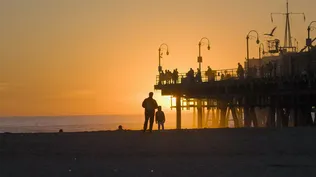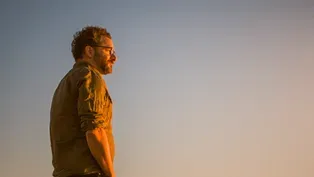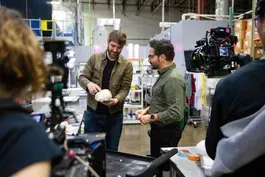
How Moments of Complexity Offer Opportunities for Change
Clip: Episode 2 | 6m 11sVideo has Closed Captions
Ari explores how moments of tremendous change offer the opportunity for tremendous growth.
Boyan Slat, the founder of The Ocean Cleanup, highlights that instead of waiting for someone else to solve problems, we should actively engage in finding solutions to the issues that bother us. Ari explores how we are in a moment of tremendous change and highlights other key moments of change and disruption throughout history.
Supported by the Hoveida Family Foundation and The Rosalind P. Walter Foundation.

How Moments of Complexity Offer Opportunities for Change
Clip: Episode 2 | 6m 11sVideo has Closed Captions
Boyan Slat, the founder of The Ocean Cleanup, highlights that instead of waiting for someone else to solve problems, we should actively engage in finding solutions to the issues that bother us. Ari explores how we are in a moment of tremendous change and highlights other key moments of change and disruption throughout history.
How to Watch A Brief History of the Future
A Brief History of the Future is available to stream on pbs.org and the free PBS App, available on iPhone, Apple TV, Android TV, Android smartphones, Amazon Fire TV, Amazon Fire Tablet, Roku, Samsung Smart TV, and Vizio.
Buy Now

What It Means to Be Human
A Brief History of the Future explores the human ability to increase empathy and compassion, what values we are instilling into artificial intelligence technologies, and the need to create both a better world and a better humanity for life to flourish on this planet.Providing Support for PBS.org
Learn Moreabout PBS online sponsorship[light music] ♪ ♪ - It's an unforgettable experience to spend time with people who simply refuse to give up, building on ancient wisdom to look beyond our modern moment to a future worth fighting for.
These are the stories we need right now.
It's so easy to see what's wrong and even easier to lose hope altogether.
But the creativity comes in finding new ways to do something about it.
I'm in Rotterdam to meet Boyan Slat, who's doing this very thing, inventing a technology designed to give our oceans a second chance.
Tell me how you got started.
- I was 16 years old.
I went scuba diving in Greece.
And I was hoping to see all these beautiful things.
Then I looked around me, and I just saw a garbage dump.
I just saw more plastic bags than fish.
And I was so dismayed and shocked by that that I asked myself a simple question.
Why can't we just clean this up?
♪ ♪ The Great Pacific Garbage Patch is the largest accumulation of trash in the world's oceans.
It's an area halfway between Hawaii and California.
It spans twice the size of Texas, and it contains about 250 million pounds of trash.
Plastic is one of the largest threats our oceans face today.
There's now 700 species known to be directly impacted by plastic pollution.
A few hundred of those are actually threatened with extinction.
The most uncertain factor but perhaps even the most impactful factor is the health impact to us humans.
Plastic breaks down into smaller, smaller pieces.
They transport toxic chemicals into the food chain, and that's a food chain that includes more than three billion people that rely on fish as their key source of protein.
♪ ♪ - Boyan and his team are working towards a goal to clean up 90% of floating plastic pollution.
And here's the most powerful part.
It took several attempts before they created something that even had a chance to achieve that.
It was touch and go.
People said the system he was inventing would never work.
But then it did.
[wondrous music] - So the system itself is a long, U-shaped floating barrier that we drag forth very slowly just to make sure that the fish can escape in time.
It acts like a funnel, plus it goes towards the center where we have what we call the retention zone, which is a collection bag.
Every few days when it's full, we take the bag onto a ship.
We empty it, sort the waste.
And then ultimately, we bring it back to land for recycling.
♪ ♪ Actually, the oldest object we ever collected.
And you can see how it's being degraded.
- Yeah.
- So these flakes are coming off.
The thing is because of UV light, because of the sun, the plastic becomes more brittle.
So then layer by layer, like an onion, it kind of peels.
- So this eventually can end up in the fish that we eat.
- Yeah.
And this can turn into millions of pieces of microplastics.
- Yeah.
- So in here, what you see is the, essentially, the recycling process in steps.
So actually half of what we get out of the Great Pacific Garbage Patch is fishing nets.
- Mm-hmm.
- So it looks just like this.
- Yeah, yeah, yeah.
- I would say probably the most harmful type because this, of course, ensnares a lot of wildlife.
So what we then do is we wash it, and we shred it to get to this kind of pulp.
- Yep.
- And then ultimately, we injection-mold it, we compound it, so we add some additives to make sure that the materials is safe and high quality.
And then it becomes this.
So these are what you call pellets.
And these are the building blocks for any new object.
So you can just mold this into something new, and the idea is that we are producing durable, sustainable products out of this, and with that, help fund the cleanup.
Actually, as a proof of concept, we made these sort of high-end designer sunglasses.
- Wow.
- So this is 100% made from the plastic we took out of the Great Pacific Garbage Patch.
They look good on you.
- These are great.
So if the Garbage Patch is cleaned up in 10 to 15 years, what's to prevent another one 20 years from now forming?
- Realistically, the amount of plastic that's being produced is not going down.
In fact, the projections are that by 2060, the amount of plastic produced will increase threefold.
So really what we need to do is we need to decouple the plastic usage from the plastic flows into the ocean.
♪ ♪ We have interceptors now in 11 rivers, some of the most polluting rivers in the world.
And we believe we can really stop most of the world's plastic emissions from leaking into the ocean.
- What do you think when people say what you're doing is impossible?
- I think when somebody says something is impossible, I think the sheer absoluteness of that the statement should make you suspicious of it.
If you look at history, everything that we now take for granted used to be impossible at some point in time.
So if you're an entrepreneur, if you're trying to make something, if you're trying to create something, yes, I think it's very important to listen and to listen to people's advice.
But if there's one bit of advice that you should really ignore, it's people who say that something can't be done.
♪ ♪ - The challenges facing Boyan and us all are daunting.
Intertidal times are full of danger, but it's also where all the creative juice is.
And for those of us who want to push the envelope on who we are and what's possible on this planet looking forward, this is our moment.
[explosions] - Man, one of the most fragile of Earth's creatures, the builder of civilization, entrusted by nature with the unique but dangerous ability to alter the very conditions that gave him rise.
- We've been in moments like this before.
The big one is moving from hunter-gatherer to agricultural.
That was maybe 10,000 12,000 years ago.
[contemplative ambient music] We went from being in small clans and tribes to now actually starting to urbanize.
We also have things like the Gutenberg press.
So we went from an era where knowledge could only be held by a few people to now being able to mass-create knowledge in a way that would actually bring it out to people.
Now from that, you got the Reformation and all sorts of upheaval around Europe and around the world.
Another one is kind of moving from this idea that the Earth is the center of everything, to moving towards heliocentric models of how the world works.
Moving from us being the center of the universe to just being one kind of node in a multi-noded galaxy and universe was highly disruptive.
The Industrial Revolution, moving from this idea that the power that we had in the world was just what we could do with our own hands and backs and change where we lived, what we ate, how we travel.
It changed how we fought wars.
And it also fundamentally changed the way we told stories about who we are and where we're going.
When we go through these moments of flux and creativity, all sorts of new things starts to arise.
♪ ♪
Video has Closed Captions
How do we make sense of today’s exponential rate of change and disruption? (30s)
Using Innovative Forms of Design to Transform Tomorrow
Video has Closed Captions
Ari explores the potential of using mycelium-based materials for sustainable products. (9m 18s)
Providing Support for PBS.org
Learn Moreabout PBS online sponsorshipSupported by the Hoveida Family Foundation and The Rosalind P. Walter Foundation.
















